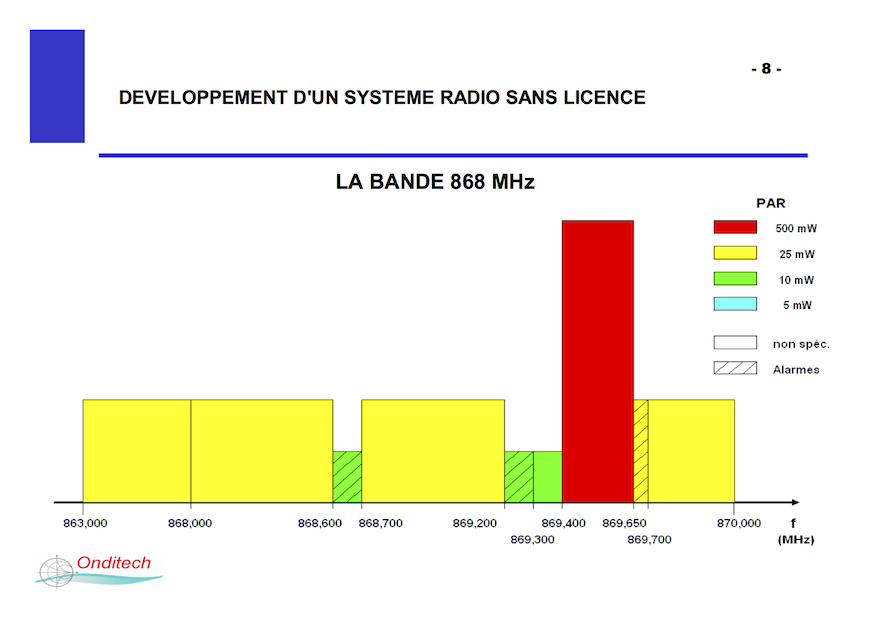Frequency bands adapted to this project¶
- License-free band
For the design of radio systems of small range and low emission power, the Annex 7 of the TNRBF specifies bands with no license requiered to transmit, but there is a limitation on the EIRP. They are a simple solution to the frequency research, and there is no need to request a frequency band to the ANFR. In particular, the section for non-specific equipment is particularly adapted for TM/TC activities, data and video transmission (c.f. ANNEX I ).
Considering the drone-like aspect of our communication link, we have taken advice from the company Fly-n-sense, specialized in UAV solutions. For them the 868 MHz frequency offers good performance. In fact, there are two suitable bands with different characteristics:
- 868,7-869,2 MHz offers a 500 kHz bandwidth and ERP=25 mW leading to EIRP=41 mW
- 869,4-869,65 MHz offers a 250 kHz bandwidth and ERP=500 mW leading to EIRP=820 mW
With
ERP: effective radiated power (ERP), often used to describe low frequency systems.
EIRP: effective isotropic radiated power (EIRP), often used to describe high frequency systems.
And
EIRP=ERP ×1,64
Considering our long range application, the 500 mW ERP band seems to be better adapted, but there is a trade off to make with the bandwidth available, especially for the video transmission that requires large bandwidth.

Although it appears to be the fastest and easiest way to define the frequency range of a system, the use of a free band is risky for the user. Indeed, there are no guaranties of non-jamming for users of license-free radio systems. In our case, a permanent link should be maintained between the aircraft and the ground station, considering that the aircraft will fly around the city of Toulouse and transmit uniformly to a region of more than 100 km all around its antenna. We need a license to perform such emission from the aircraft on the city of Toulouse: the solution is to send a frequency allocation request to the ANFR.
- License band
The process of frequency allocation is long and administratively complex, that’s why we asked for information at an early stage of the project.
As we said before, the RF spectrum is shared among services and users. Our application being a air/ground link, we began to search for frequency bands dedicated to the service named MBA (Mobile for Aeronautical services) and affected to the user DEF (Ministry of Defence), because ISAE is under the tuition of Defence Ministry. There, it appears that the 5091-5150 MHz band should fit our application (c.f. ANNEX II ).
- Methodology for the project
We choose to study the performance of the system design considering the two previous bands : 869,4-869,65 MHz, and 5091-5150 MHz, in order to keep doors opened and see the influence of both bands.
In order to simulate the system performance and find the required parameters, we need the EIRP and bandwidth available for our application in the 5091-5150 MHz band. According to our research in the litterature, we will fix the bandwidth to 5OO kHZ, and the EIRP to 1W.
This is a very high contraints in terms of "RF pollution", especially in a highly dense aeronautical/spatial pole such as Toulouse.
